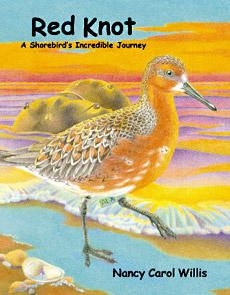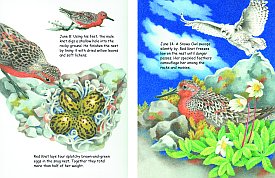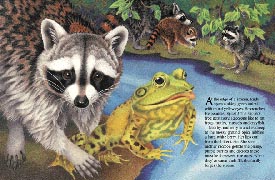|
TOP of Page |
|
Clear rhyming text paired with large-scale, beautifully-detailed colored pencil illustrations describe how 13 North American animal species survive the winter snows snug inside their dens, nests, burrows and lodges.
Peek inside each winter home for a close-up view. Then locate all of the homes together on the final panoramic illustration.
Two educational pages provide additional species information, depict animal tracks in the snow, and ask questions designed to encourage children to look for details in the pictures.
|
|
|
|
 |
Where do the northern animals sleep when it's nose-stinging cold and the snow drifts deep?
Bedded down in the spruce grove, where the howling winds don't blow (White-tailed deer).
|
|
In a hollow log near the old fence row (Snowshoe hare).
Wedged between the rocks, sleeping all alone (North American porcupine).
|
 |
 |
Snug together under a crumbling wall of stone (Striped skunk).
|
|
TOP of Page |
Red Knot: A Shorebird's Incredible Journey
by Nancy Carol Willis
Birdsong Books, ages 6-10, 32 pages, 8 1/2 x 11
ISBN 978-09662761-4-5, Hardcover
ISBN 978-09662761-5-2, Paperback
|
 |
 |
|
Follow the dramatic story of one bird's 20,000-mile migration from the tip of South America to the High Arctic to nest & raise her young.
To learn more about shorebird field research, we have the following download for you to view in either Microsoft Office or OpenOffice.org Presentation formats:
The Red Knot in our book wears a lime-green flag with the letters "ALX." Nancy chose those letters for her dog, Alex. She then learned ALX was an actual Red Knot that was banded in Delaware Bay on May 14, 2004 weighing 115 grams. ALX was sighted wintering in Tierra del Fuego and again in Delaware Bay during May, 2005 and 2006. On May 17, 2007, ALX was photographed by Patricia M. Gonzalez at Fortescue Beach, NJ. On May 21, 2008, ALX was spotted on Fowler Beach and later in Mispillion Harbor, DE. Let's hope we see him again next year!!
|
 |
June 8: Using his feet, the male knot digs a shallow hole into the rocky ground. He finishes the nest by lining it with dried willow leaves and soft lichens.
Red Knot lays four splotchy brown-and-green eggs in the snug nest. Together they total more than half of her weight.
June 14: A snowy owl swoops silently by. Red Knot freezes low on the nest until danger passes. Her speckled feathers camouflage her among the rocks and mosses.
|
|
July 3, chicks hatch: Within hours, four downy knots snatch flies and mosquitoes to eat. Near the Arctic Circle, food is now plentiful, and the sun never sets.
July 10: Red Knot departs on her southward migration, leaving her mate to protect the chicks.
July 22: The male knot leaves the Arctic, a month before his young, who can now care for themselves.
|
 |
 |
August 1: Unseen, a hungry arctic fox approaches the young knots. He drops low to the ground. He creeps closer. He lunges. Knots scatter in all directions, diving for cover. The fox chases one bird, then another, but catches nothing!
|
|
TOP of Page |
Raccoon Moon
by Nancy Carol Willis
Birdsong Books, ages 4-8, 32 pages, 8 ½ x 11
ISBN 0-9962761-2-4 $15.95, Hardcover
ISBN 0-9962761-3-2 $7.95, Paperback
|
|
Selected as the
Read-to-Me book
for the children's nature magazine:
’Your Big Backyard‘
September, 2005
www.nwf.org
|
 |
 |
"A round April moon rises over an old silver maple tree. Inside the hollow trunk, raccoon cubs are being born. Rusty, Rudy and Spice are only four inches long. They cannot see or hear. Each weighs two ounces, about as much as a candy bar.
"Err, err, err," they cry. Mother raccoon gently nudges the cubs onto her belly, where they nurse on warm milk."
|
|
"It's the June summer solstice, the shortest night of the year. Mother raccoon calls for her cubs to follow. Raccoons are nocturnal, which means they hunt at night. If they are to one day survive on their own, the cubs must learn to forage for food. They follow mother raccoon down grassy paths lit by a yellow moon."
|
 |
 |
"At the edge of a stream, Rudy spots a shiny green animal with round yellow eyes. He crouches. He pounces. Splash! The slippery frog gets away. Raccoons like to eat frogs, turtles, mussels and crayfish.
Nearby, mulberry branches droop to the mossy ground. Spice nibbles a hard white berry. Her lips curl from the bitter taste. She sees mother raccoon gobble the plump, purple berries and decides those must be the sweet, ripe ones. When they've eaten their fill, the family forges the stream."
|
| Raccoon Moon includes three pages of information designed to make children, teachers and parents instant experts on raccoons. Included are a glossary, raccoon trivia, information on the raccoon's name and range, raccoon relatives, a breeding season timeline, and tips for emergency care of injured or orphaned raccoon cubs. |
  |
|
The Robins In Your Backyard
by Nancy Carol Willis
Birdsong Books, ages 4-8, 32 pages, 8 ½ x 11
ISBN 0-9962761-0-8 $15.95, Hardcover
ISBN 0-9962761-1-6 $7.95, Paperback
|
 Kid-pleasing facts and beautifully-detailed, large-size colored pencil illustrations show kids how robin parents raise and care for their young. A glossary and guide to aiding orphaned and injured songbirds is included. Awarded the Parent Council seal as outstanding for children ages 4 to 7.
Kid-pleasing facts and beautifully-detailed, large-size colored pencil illustrations show kids how robin parents raise and care for their young. A glossary and guide to aiding orphaned and injured songbirds is included. Awarded the Parent Council seal as outstanding for children ages 4 to 7.
Book Reviews and Awards
|
|
 |
 |
 |
Several days have passed, and now there are three shiny, blue eggs in the nest. The eggs stay warm under mother robin's breast feathers. From time to time, she rolls each egg to keep it warm all over so that the baby inside can grow. |
If you could look inside the egg, you'd see a tiny embryo and a yellow yolk surrounded by a watery liquid. The yolk provides food for the embryo as it grows into a bird. |
In six days, the robins' eyes open and their feathers start to grow. Nestling robins grow really fast. If you grew at the same rate, you would weigh 90 pounds by the time you were ten days old! |
 |
Learning to fly can be dangerous. Bad weather and predators like cats are the young robin's greatest enemies. Father robin scurries about for two more weeks while he feeds and protects his rowdy brood. |
| The Robins In Your Backyard includes a glossary, breeding season timeline, and emergency care and feeding of injured or orphaned baby birds. |
|
|
|
The Rock
by Daniel A. Birchmore
Illustrated by Nancy Carol Willis
Cucumber Island Storytellers, ages 4-7, 32 pages, 6 x 9
ISBN 1-887813-03-9 $14.95, Hardcover
|
| A simple, fictional story of geologic and evolutionary time illustrated with bright, colorful crayons. |
 |
|









